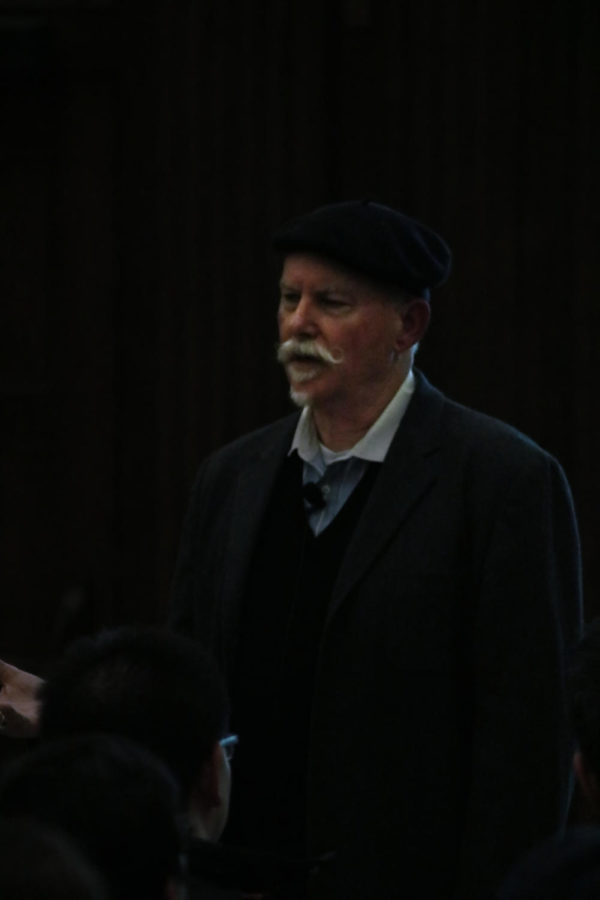The Alchemy of Creativity: Berkeley professor shares his creative process
Chip Sullivan, landscape architect, artist, and professor at University of California Berkeley, gives a lecture in the Memorial Union on Monday, April 9. Sullivan is known for incorporating artistic elements into his landscapes.
April 9, 2018
Renowned landscape architect, artist, draftsman, and University of California, Berkeley professor Chip Sullivan presented a synthesis of his work on the creative process in the South Ballroom on Monday, sharing a life’s worth of creative insights and inspirations to inspire students to achieve their own creative potential.
Sullivan said it was strange to be back at Iowa State, as his first professional exhibition and lecture was actually at the university nearly 30 years ago. Since then, Sullivan has gone on to publish multiple lawded books on landscape architecture, drawing, and creativity and become a recipient of the Rome award for his work in landscape architecture as an art form.
He has spent much of his career espousing the possibilities of tapping creative avenues to design sustainable landscapes that evoke strong feelings of place in the people who interact with them.
Steeped in the culture of the Berkeley scene, Sullivan’s lecture was an exposition of his journey in creative works, from his love of comic art and prolific authors in his early childhood to his innovative approach to environmentally-friendly landscape design.
The son of an aspiring cartoonist, Sullivan gained an interest in comic books from a young age and learned to draw by imitating illustrations from “Mad Magazine”, which didn’t impress his teachers much at all. At the time, comic books were considered a deviant art form and not a serious element of art culture.
However, Sullivan saw in the drawings of great comic artists— such as Jack Kirby, Wally Wood, and Ed Roth— a style that captured the essence of the world, and said that for him, sitting down with a pencil and paper opened a portal to a new world.
He also cited the books of Carlos Castaneda and Beat generation poet Jack Kerouac as influences that opened him up to new creative possibilities.
After graduating from the University of Florida with his MA in Urban and Regional Planning, Sullivan was faced with a tough job market and was only able to find employment in a large corporate architecture firm.
Unsatisfied with the work he was doing for the corporation, Sullivan would spend most of his nights drinking coffee and working on personal projects until 3 a.m., eventually receiving recognition for his innovative landscape designs that were meant to help reduce society’s dependence on fossil fuels, earning him the Rome award and leading to the success of his later career.
As an educator, Sullivan said he aims to impart in his students the importance of allowing your creativity to guide you in your work, and to always follow the feeling of the project.
Sullivan’s approach to creative works draws inspiration from the subconscious, using a variety of methods to tap into what Sullivan calls the “Spirit of the Place”— the feeling that attaches a sense of meaning, importance, or transcendentalism to an environment.
Some of Sullivan’s methods for tapping this creative energy involve adopting practices that help the artist to capitalize on their most creative moments— keeping a journal, working their schedule around the hours of the day when they feel most creative, establishing reward systems to motivate the artist to complete set goals and drawing inspiration from dreams.
Sullivan said that some of his best work, like the work of other amazing artists like Salvador Dali, came to him through dreams that he was able to preserve by recording the major symbols and events of the dream right after waking, and encourages every artist to keep a dream journal.
Sullivan said his major aim in bringing this lecture to campus was to inspire students to be bold in their creative process, and never give up on their aspirations.
“My number one thing is that everybody has power within them, everyone is creative,” Sullivan said, “It’s just a matter of believing in themselves. You have to be able to take rejection and keep moving forward.”
















